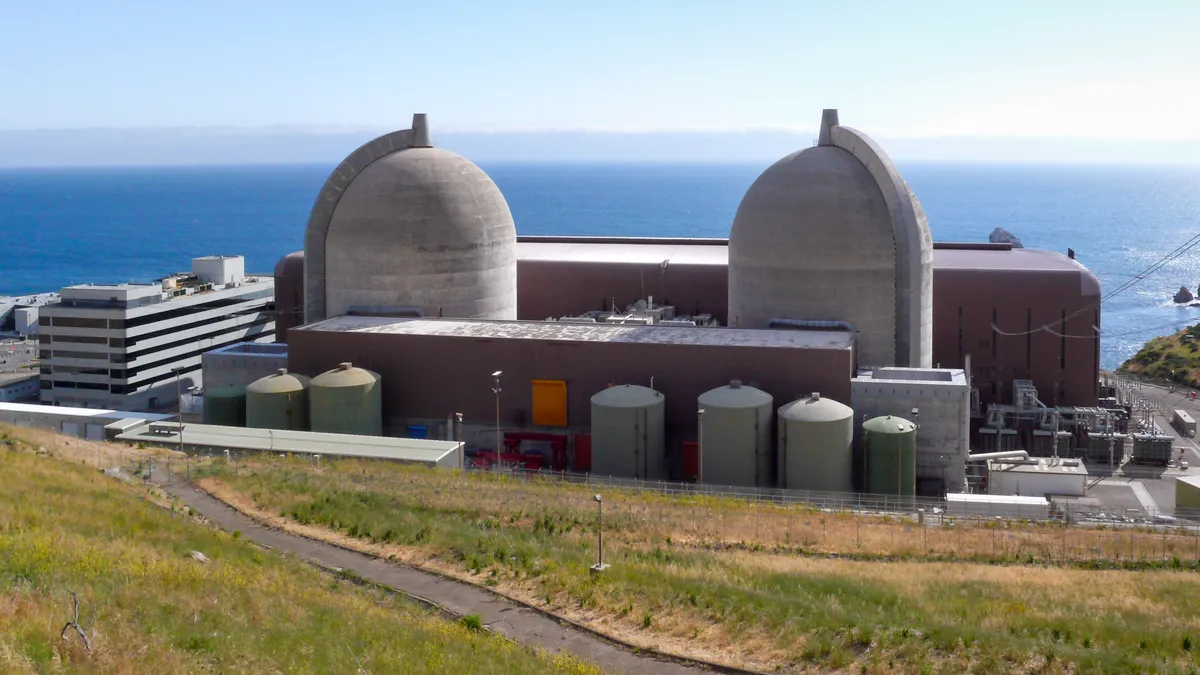Dive Brief:
- California regulators on Thursday voted to open a rulemaking to consider extending the operations of the 2.2-GW Diablo Canyon nuclear power plant, the last operational nuclear facility in the state.
- The rulemaking stems from legislation approved last September, which among other things required the California Public Utilities Commission to issue a decision by the end of this year establishing new retirement dates for the two units of the nuclear plant.
- The Diablo Canyon nuclear plant, which is owned and operated by Pacific Gas & Electric, is currently licensed to operate until 2024 and 2025 for each of its two units respectively. In 2018, state regulators approved a plan to retire the facility once these licenses expire.
Dive Insight:
Last year, amid larger concerns around grid reliability in California, lawmakers passed SB 846 to keep open the possibility of extending the plant’s life.
This reversal largely boiled down to two factors, according to the office of California Gov. Gavin Newsom – delays to new renewable energy and storage projects, thanks to global supply chain disruptions, as well as a new $6 billion federal program that could help support the nuclear plant.
Under SB 846, Diablo Canyon Unit 1 could be kept running through Oct. 31, 2029, and Unit 2 until Oct. 31, 2030.
In November, PG&E applied to the U.S. Nuclear Regulatory Commission to keep the plant running until 2030.
Under the umbrella of its new rulemaking, the CPUC could either authorize extending operations at the plant through 2029 and 2030, or establish earlier retirement dates. This would be dependent on a variety of factors – for instance, if the NRC either opts not to extend the lifespan of the nuclear plant, or renews operations at the plant for a shorter period, or if regulators determine that the conditions of the NRC’s license renewal will lead to unjustifiably high costs.
Alternatively, regulators may also opt for earlier retirement dates if they conclude that there are adequate new zero-carbon and renewable resources in the state to replace the Diablo Canyon plant without jeopardizing grid reliability.
Once the commission has decided on retirement dates for the nuclear facility, it will then work on establishing a new process to recover the costs and expenses of continuing to operate the plant, according to its order.
California stakeholders remain split on the state’s reversal on the future of the Diablo Canyon nuclear plant.
“The rush to keep Diablo Canyon running beyond 2025 is not only dangerous, but will set back California’s drive to make solar and wind the prevailing sources of electricity in the state,” Ken Cook, president of the Environmental Working Group, said in an emailed statement.
Nuclear advocates, however, say that the energy source has a key role to play on California’s grid. If the Diablo Canyon power plant were to shut down today or in 2030, “California will be in a world of hurt,” Gene Nelson, senior legal researcher with Californians for Green Nuclear Power, said in an email.
“Unlike inherently intermittent solar or wind, DCPP runs 24-7, day or night, wind or calm, flood or drought,” Nelson said, adding that typically, the nuclear plant undercuts the cost of California natural gas-fired generation.














